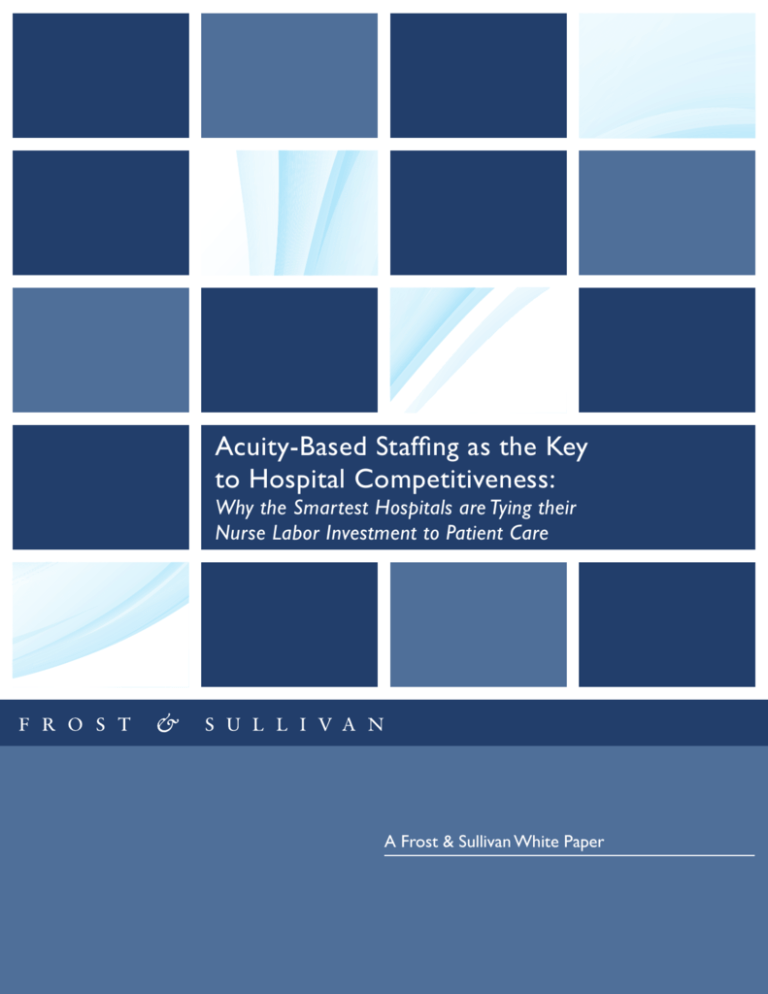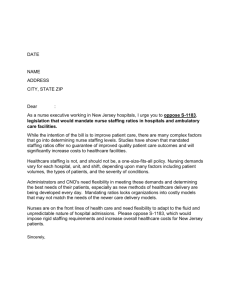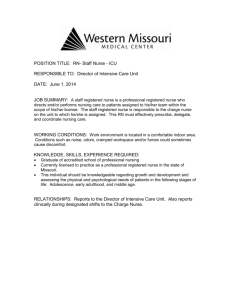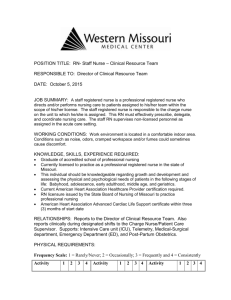
Acuity-Based Staffing as the Key
to Hospital Competitiveness:
Why the Smartest Hospitals are Tying their
Nurse Labor Investment to Patient Care
A Frost & Sullivan White Paper
frost.com
Acuity-Based Staffing Solutions:
A Foundation for a New Era of CFO and CNO Partnership.....................................................3
The Future Evidence-Based Practice Landscape of Hospital Care..........................................5
Why Having a Nurse Workforce Plan with a Technology Solution is Essential........................5
Acuity-Based Staffing Solutions and Best Practices...................................................................6
Nursing Practice and General Tools............................................................................................ 6
Productivity and Financial Management Tools.......................................................................... 6
Acuity-Based Staffing Solutions.................................................................................................... 7
Considerations in Selecting an Acuity-Based Staffing Solution................................................ 9
Key Takeaways.................................................................................................................................10
contents
Acuity-Based Staffing as the Key to Hospital Competitiveness
At no time has managing nurse resources been more important to hospitals than today. Acuity-based nurse
staffing systems are becoming the standard of care in hospitals to manage valuable nursing resource and
deliver quality care. Find out why leaders are adopting technology and gain insight into successful adoption
of these systems.
ACUITY-BASED STAFFING SOLUTIONS: A FOUNDATION FOR A NEW ERA OF
CFO AND CNO PARTNERSHIP
Value-based healthcare is placing an increased focus on managing quality outcomes. Nursing is a key component
of care delivery and a major cost for hospitals. This is resulting in increased attention to nurse staffing practices
and costs. Hospitals have the challenge of achieving quality patient outcomes, maintaining a committed and
stable nursing workforce, and delivering strong financial results – the triad that supports competitiveness.
Figure 1
The optimal management of nurse staffing
directly supports hospital competitiveness.
Achieving quality
patient outcomes
Hospital
Competitiveness
Maintaining a
commited and
stable nurse
workforce
Effectivenesly
managing nurse
staffing costs
Today CNOs and CFOs are forming a new level of partnership to drive optimal use of resources and assure
quality care. Acuity-based nurse staffing systems play an essential role in nurse workforce programs and enable
a new era of finance partnership.
Nurse staffing is generally understood to represent 35-40% of hospital costs. In acute care facilities, nursing
can account for as much as 50% of total costs and provides 95% of its patient care (Nguven, 2006). Maintaining
a stable nursing workforce and the mix of competencies required for quality patient care can be challenging.
Nurse managers struggle with pressures to use lower-competency personnel to reduce costs and address
nursing labor shortages. When nursing is under-staffed, the subsequent stress on nurses causes burnout.
As many as half of nurses report insufficient time with patients and 96 out of 100 report fatigue at the
beginning of a shift (ANA Nurse Staffing, 2014). A study referenced by the Agency of Health Research and
Quality (AHRQ) found that each additional patient assigned to a nurse led to a 23% increase in the risk of
nurse-reported “burnout” and a 15% increase in the risk of a nurse being dissatisfied with his/her job (Aitkens,
et al, 2002). If a hospital is not able to maintain a stable nurse workforce, not only are patient outcomes, safety
and satisfaction at risk, but nurse satisfaction and retention deteriorates, resulting in additional recruitment,
overtime and agency personnel costs. US hospital average nurse attrition is 14% with a 13-week impact on
productivity to recruit and train replacement personnel (KMPG, 2011).
All rights reserved © 2015 Frost & Sullivan
3
frost.com
Nursing resources are allocated based on patient need, or acuity, as a measure of the intensity and complexity
of care required by a patient. Patient acuity can be difficult to assess. Patient acuity and patient numbers change
within shifts. There are growing mandates and literature about safe staffing nurse-patient ratios (ANA Nursing
World, 2014). Regardless of mandates, many hospitals are already considering staffing ratios and patient acuity as
part of staff plans (Lolla Mitchell, August 2014). And there is a body of evidence that staffing aligned with patient
acuity directly and positively impacts medical errors, falls, hospital-associated pressure ulcers (HAPU), and other
adverse events, such as readmissions (Colbert, 2014). Patient staffing is a complex issue, but a method that
incorporates nurses’ input and provides evidenced-based data is valued (Hertel, 2012.)
Nurse leaders are discovering the power of IT as a strategic labor planning tool to maximize use
of nurse competency and skill mix, provide consistent and safe staffing, and foster a new nursing
and finance partnership.
A new breed of acuity-based staffing IT solutions are available today and considered by many to be essential for
the planning, real-time management, and optimization of nurse staffing. Nurse managers can plan and manage
staffing with greater ease, consistency and accuracy based on multiple considerations important to nursing.
These systems support a standardized approach to assessing patient acuity where transparent classification is a
byproduct of the clinical documentation process. The solutions enable nurses to improve their documentation
skills and provide quality bedside care. Nurse administrators can maintain a stable nursing workforce, improve
patient and nursing satisfaction scores, and avoid incidental overtime or agency personnel costs. Importantly,
the reliable data and reporting provided by these solutions builds a “bridge” with financial leaders less familiar
with clinical care.
Figure 2
Acuity-Bases Staffing Solutions Allow Hospitals to Manage Nurse
Staffing for Optimal Care Delivery and Cost
Complex Care
Considerations
Strategic Workforce
and Technology Plan
Financial Viability and
Market Competitiveness
Nursing Workforce Plan
Quality
Outcomes
Safety
Costs
Nursing
Workforce
and Mix
4
Risk-Based
Payments
Quality
Metrics,
Satisfaction
Scores
Acuity-Based
Staffing Solutions
Nursing and OrganizationWide Collaboration
All rights reserved © 2015 Frost & Sullivan
Achieving Quality,
Safety and Cost Goals
Acuity-Based Staffing as the Key to Hospital Competitiveness
THE FUTURE EVIDENCE-BASED PRACTICE LANDSCAPE OF HOSPITAL CARE
Hospitals and clinicians are increasingly being asked to take on more risk under value-based care.
Reimbursement is tied to quality outcomes, as with 30-day readmit penalties. Hospitals are required to
report on a diverse range of quality measures and also may need data to support any adverse event claims.
There is increasing transparency on performance. The marketplace today for hospital services is competitive
and demands demonstrating quality outcomes.
Nurse staffing has recently drawn renewed interest given the impact nursing has on patient outcomes, the high
percentage of hospital costs associated with nursing, and the risks and costs associated with adverse events.
Financial aspects of nursing are complex to manage. Nurse staffing needs to be planned and flexed up or down,
often in real time. Patient acuity mix for a facility can change over time. Industry changes, such as utilization of
outpatient centers for less-complex procedures and pressure for shorter hospital stays, are potentially resulting
in higher patient acuity during hospital stays. Patient satisfaction based on Hospital Consumer Assessment
of Healthcare Providers and Systems (HCAHPS) survey scores impact reimbursement and also a facility’s
reputation. Hospitals desire to get the most from their labor dollars and to manage nursing resources well.
This improves the chances of HCAHPS bonuses and mitigates the risk of penalties for readmission and other
adverse events. Improved nurse satisfaction encourages retention and reduces recruitment and training costs.
The ability to accurately forecast staffing needs avoids costly overtime and agency personnel.
Nurses have traditionally used patient volume to allocate staffing. Today, a new breed of acuity-based staffing
solutions are available that support optimal management of nursing staff and costs.
WHY HAVING A NURSE WORKFORCE PLAN WITH A TECHNOLOGY
SOLUTION IS ESSENTIAL
Today’s environment requires new approaches to assure quality outcomes and financial sustainability, and
technology has become a key part of a strategic labor plan for nurse leaders. Technology solutions are a valuable
tool to improve and standardize workflow, and to be able to plan effectively, respond to changes in real time,
and make quality staffing decisions. The challenge becomes defining the best-fit technology solution, supporting
the case for adoption, and achieving successful organization integration.
While not all hospital nursing environments involve the complexity of care that requires a technology solution,
many do. Facilities, or hospital units, with stable patients and predictable patient flows may not require these.
However, small, medium and large hospitals, with flows of surgical, specialty or emergency care patients, can
benefit significantly.
The availability of acuity-based staffing technology solutions means that traditional nurse-staffing practices
become the foundation, and the solutions enable greater standardization in patient acuity classification and
accurate and up-to-date patient acuity. This leads to optimal staffing decisions for quality care, improved patient
and nursing satisfaction, and mitigates the need for higher-cost labor. In this scenario, nurse staffing and cost
management are tied directly to patient care. Hospitals with complex patient flows and acuity operating without
acuity-based technology solutions potentially risk underperforming operationally, clinically and financially.
The importance of acuity-based staffing solutions increases as hospitals transition to risk-based reimbursement
and data-driven management:
All rights reserved © 2015 Frost & Sullivan
5
frost.com
Figure 3- Acuity-Based Solutions to Strategic Workforce Planning Continuum
Transition to Value-Based Care and Risk-Based Reimbursement
Key Environment Drivers
FROM
TO
Patient complexity
and acuity
Patients considered similar based on
diagnosis/unit population
Differentiating patients based on
variability and complexity
Nursing workforce
Core staffing based on HPPD*
Flexible staffing based on patient’s needs for
care, incorporating patient volume, workload
and complexity of care
Reimbursement and
financial environment
Targets- and incentive-based
Strong financial management incorporating
patient acuity and complexity
Nursing and finance
collaboration
Traditional collaboration
Strong nursing, finance and
organization-wide collaboration
* Nursing hours per patient day (HPPD)
ACUITY-BASED STAFFING SOLUTIONS AND BEST PRACTICES
Optimal staffing leads to optimal outcomes and requires matching nurse staffing numbers and competencies to
patient acuity.
Leading solutions enable:
• Patient classification methodology that is evidence-based and updated every few years to match the
evolving needs of the clinical specialty and hospitals practices;
• Ability to assess patient complexity and make objective, evidence-based recommendations to improve
staffing allocations;
• Benchmarking database to compare performance against other hospitals and departments, incorporating
acuity as an important comparative data point;
• Ability to quantify how changes in nurse staffing impact relevant patient outcomes and safety;
• Management reporting capabilities to help with nursing labor budgets and strategic planning; and
• Sophisticated forecasting capabilities to help with future staffing challenges.
Nursing Practice and General Tools
Nurse staffing best practice is based on critical thinking and judgment, and may be supported by general tools
such as Microsoft Excel. Nurse managers generally assess and document staffing needs several times a day,
especially in medical, surgical or other areas with high patient flow, typically in the morning and then at each shift
change. Reporting normally includes actual compared to target hours. In some facilities there may be dedicated
nurse roles responsible for checking each nurse’s assessments. These approaches can work well in environments
with low complexity and variability.
6
All rights reserved © 2015 Frost & Sullivan
Acuity-Based Staffing as the Key to Hospital Competitiveness
Productivity and Financial Management Tools
Hospitals may also use staffing or financial tools that enable benchmarking to targets and reporting. These tools
can make valuable administrative contributions, but not in areas deeply related to nursing care, such as improved
classification of patient acuity, supporting real-time decisions, and assuring balanced assignments. Some hospital
systems commit to building a proprietary solution, but may find it difficult to commit the necessary resources
for support and to maintain validity to current practice (such as new technology and equipment, or nurse
practice change).
Acuity-Based Staffing Solutions
Acuity-based staffing solutions seek to support nursing practice with valuable workflow, analysis and reporting.
Patient acuity vendors are committed to research, validation to new practice, and successful implementation.
They enable nursing to easily define a proactive six- or 12-month plan, confidently set staff for the next 24
hours, and manage staffing in real time. For entities with tight financial constraints, the solutions are particularly
helpful in supporting the case for nurse staffing levels. For hospital groups, they support system-wide efforts to
standardize and improve safety, quality and cost. For all facilities they provide clinical information and analytics
that are increasingly important to hospital care delivery and competitiveness.
Acuity-based staffing solutions provide nursing with:
1.Transparent classification
2.Complexity of care
3.Discharge management
4.Patient-care assignment
5.Outcomes management
6.Management reporting
Frost & Sullivan conducted a series of interviews to understand best practices in leading
hospitals today.
North Shore Medical Center, a Partners Healthcare facility in the Boston area, uses AcuityPlus, an acuitybased staffing solution from QuadraMed. Diane Menasco, nursing coordinator, shared that the transparent
classifications and ability to know true admittance and transfer through connectivity with the Admittance,
Discharge and Transfer system is highly valued by nursing staff. Beyond the staffing model generated based
on patient acuity, nursing management reviews assignments and makes adjustments similar to the way that
would be done under traditional (non-technology) methods, but with the added ability to easily ensure overall
workloads are appropriately spread between the nursing staff. The ability to augment emotion or industry
ratios with logical and transparent data is valued and has resulted in a strong nursing and finance partnership
and collaboration within nursing and across the Partners organization. Nursing staff appreciate the quality
research and validation to current practice provided by QuadraMed that enables meaningful benchmarking.
All rights reserved © 2015 Frost & Sullivan
7
frost.com
Today, nurses need to not only understand bedside patient needs, but also the
organization’s need to be financially well-managed,
said Menasco
Mayo Clinic also has an organization-wide commitment to acuity-based staffing and uses AcuityPlus. All
nurses are trained in patient classification, value the acuity-based staffing solution and can pull key reports. Those
doing the work are the same people who review the workload. Nurses actively seek to improve their criticalthinking skills and achieve high (94% target) scores of predicted versus actual hours. Nursing staff review compliance
and accuracy scores monthly and value having factual data as part of the conversation. Mayo seeks to stay within
1-2% of the predicted recommendations, and find if it drops to 3-4%, it generally gets feedback regarding nurse
stress and patient flow issues. Kathy Matson, nursing administrator with Mayo Clinic Arizona, shared the importance
of having a vendor who is proactive with education, updates and resolving any issues. Nursing management is
confident in their ability to adapt to future needs and deliver quality and safe care with high levels of patient
and nursing satisfaction. Matson also pointed out that nursing leads the utilization of the solution and needs to
have an ongoing commitment to the use of data, a small team to manage the solution, and support from the
IT organization.
AcuityPlus builds a bridge between nursing and finance, enabling the 24x7 world of
nursing to be understood by the 8x5-hour finance team.
said Matson
Coy Smith, associate director of Care Services and CNO at Philadelphia’s Veteran Affairs Medical Center, has
experienced a range of nurse staffing systems from critical thinking and paper-based patient ranking systems,
to general staffing solutions and acuity-based solutions, including AcuityPlus. Smith shared that a system should
ideally match to the organization philosophy and needs, including whether acuity data is useful to make the case
for staffing levels. Smith found acuity-based staffing solutions valuable to proactively plan, manage in real time,
and make the case for staffing levels with finance.
8
All rights reserved © 2015 Frost & Sullivan
Acuity-Based Staffing as the Key to Hospital Competitiveness
CONSIDERATIONS IN SELECTING AN ACUITY-BASED STAFFING SOLUTION
Nursing leadership, along with hospital finance and IT, need to decide on the best-fit nurse workforce and
technology plan for their environment, and identify nurse coordination resources for successful implementation.
Considerations in designing a Nurse Workforce and Technology Plan include where the organization is today
and its future vision:
Figure 4
Nursing Workforce and Technology Plan Evolution Steps
Technology as a
Strategic Partner
Patient Acuity
System
Value for
Nursing
Return On
Investment
(ROI)
General Tools
Staffing and Financial
Management Tools
Focused Acuity-Based
Staffing Solutions
• Paper-based system
• Excel-based system
• System embedded as a shell
within another system
• Added function to another
primary product (i.e. staff
scheduling)
• Task staff need to complete
• Descriptive system
• Research-based methodologies
• By-product of EHR, not separate
task for staff
• Limited ability to identify
acuity changes
• Limited informatics and
reporting
• Subjective
• Lack of validity and
transportability across
clinical populations
• Benchmarking focused on staffing
numbers and productivity
• Limited clinical data to improve
acuity assessment, assignments
or make real-time decisions
• Minimal acuity vendor product
expertise and focus
• Gaining nursing commitment,
education and training
• Empowers staff from the bedside to
the C-Suite
• Organization integration
• IT support and partnership
• CFO support and partnership
• Limited to no
investment in IT and
informatics for
improvement
• Investment in standardized staffing
and financial management tools
across organization
• Not standardized across clinical
populations; consistent
interpretation of workload
• Optimally manage staffing to
patient needs
• Minimize overtime and other
unplanned costs
• Meet new mandates and metrics
• Collaboration for quality care
outcomes and cost
• Quality, safety, satisfaction,
productivity and cost
improvements
• Workload measurement across
clinical populations
All rights reserved © 2015 Frost & Sullivan
9
frost.com
The most important criteria in selecting a nurse staffing technology solution include assurance of achieving:
Figure 5 - Key Criteria for Nurse Staffing Technology Selection
Nursing engagement and
organization teamwork focused on
quality outcomes
Stable and committed
nurse workforce
Financial and risk management
Accurate nurse staffing
Patient safety and
quality care outcomes
Hospitals with interest in data-driven forecasting, benchmarking and reporting; who have complex patient
mix and flows; and are committed to improving quality outcomes, typically choose an acuity-based staffing
solution. These solutions provide nursing with tools for optimal staffing decisions and patient care, and a
strong CFO partnership.
KEY TAKEAWAYS
Staffing based on patient acuity is central to ensuring quality patient outcomes, a stable nursing
workforce, and financial viability. Acuity-based staffing systems valuably augment nursing
knowledge and judgment, and assure accurate and safe staffing. A strategic nurse workforce plan
with technology enables a new level of CNO and CFO partnership that supports delivery of the
highest possible quality of care, safety and cost management.
Today’s value-based healthcare environment sees hospitals taking on greater risk. Managing nursing staff, costs
and quality care is of high importance to financial viability and market competitiveness. Leading hospitals have a
commitment to acuity-based staffing, and technology solutions are seen as a key component of their strategic
nurse workforce plan. Acuity-based staffing solutions enable staffing to be proactive, prospective, efficient and
fiscally responsible. Staffing and costs are directly tied to patient care. Nurses are able to improve their acuity
assessment skills, provide quality bedside care, and feel engaged on staffing decisions. Nurses and financial
managers value the transparency and rational data these systems provide. Hospitals are confident in their ability
to deliver quality outcomes, achieve metrics, manage costs, and maintain a stable nursing workforce.
10
All rights reserved © 2015 Frost & Sullivan
Acuity-Based Staffing as the Key to Hospital Competitiveness
Nursing leadership interested in pursuing the use of an acuity-based staffing solution should:
1. Identify the best-fit technology solution for their environment;
2. Identify a small nursing team for implementation and continued coordination;
3. Validate precision of acuity data and methodology from potential vendors for your needs;
4. Develop a collaborative dialogue with finance on nurse staffing;
5. Identify IT support for optimal integration of the acuity-based staffing solution;
6. Define, plan and implement new workflow, decision-making, and collaboration within nursing; and
7. Develop a program to educate nursing on the value and use of the solution.
Best-in-class vendors are experienced in working with hospitals of all sizes to assess, plan, implement and provide
ongoing support for these important programs. Acuity-based staffing solution vendors such as QuadraMed
exemplify the product capability, technical expertise and support that enable nurse leaders to make the right
choice and implement successful nurse workforce programs.
BIBLIOGRAPHY
1. Aiken, LH; Clarke, SP; Sloane, DM; et al. “Hospital nurse staffing and patient mortality, nurse burnout, and job dissatisfaction,” JAMA.
2002, Retrieved from https://innovations.ahrq.gov/profiles/state-mandated-nurse-staffing-levels-alleviate-workloads-leading-lower-patientmortality?id=3708
2. ANA. “Key Findings from Research Studies on Safe RN Staffing,” August 2014. Nursing World, http://www.nursingworld.org/
MainMenuCategories/ThePracticeofProfessionalNursing/NurseStaffing/2014-Nurse-Staffing-Updated-Literature-Review.pdf
3. ANA. Nurse Staffing, 2014, Retrieved 2014, 30 December from nursingworld.org: http://www.nursingworld.org/nursestaffing
Colbert, Ken. MS. “Benefits of Acuity-Based Nurse Staffing,” Advance for Nurses, February 19, 2014, http://nursing.advanceweb.com/
Features/Articles/Benefits-of-Acuity-Based-Nurse-Staffing.aspx
4. KPMG, June 2011, “KPMG’s 2011 U.S. Hospital Nursing Labor Cost Study,” Retrieved 2014, 30 December from www.Natho.org: http://
www.natho.org/pdfs/KPMG_2011_Nursing_LaborCostStudy.pdf
5. Lolla Mitchell MSN, RN. “Using acuity and complexity of patients’ conditions to staff effectively and achieve better outcomes,” Advance
for Nurses, August 4, 2014. http://nursing.advanceweb.com/Features/Articles/Overcoming-Understaffing-in-Nursing.aspx
6. Nguyen.V (2006 25-October). “Berkeley Hospital Among Six Splitting $12 Million Grant,” The Daily Californian, Retrieved 2014, 30
December from dailycal.org: archive.dailycal.org/article.php?id=21988
7. QuadraMed Case Study, “Georgia Health System Generates First-Year $901,000 Staffing ROI Using QuadraMed AcuityPlus,” www.
quadramed.com
8. Hertel, Robin. “Regulating Patient Staffing: A Complex Issue.” Academy of Medical-Surgical Nurses,Volume 21 – Number 1, January 2012,
retrieved from amsn.org
All rights reserved © 2015 Frost & Sullivan
11
Auckland
Bahrain
Bangkok
Beijing
Bengaluru
Buenos Aires
Cape Town
Chennai
Colombo
Delhi/NCR
Detroit
Dubai
Frankfurt
Houston
Iskander Malaysia/Johor Bahru
Istanbul
Jakarta
Kolkata
Kuala Lumpur
London
Manhattan
Miami
Milan
Mumbai
Moscow
Oxford
Paris
Pune
Rockville Centre
San Antonio
São Paulo
Seoul
Shanghai
Shenzhen
Silicon Valley
Singapore
Sophia Antipolis
Sydney
Taipei
Tel Aviv
Tokyo
Toronto
Warsaw
Silicon Valley
331 E. Evelyn Ave., Suite 100
Mountain View, CA 94041
Tel 650.475.4500
Fax 650.475.1570
San Antonio
7550 West Interstate 10,
Suite 400
San Antonio, TX 78229
Tel 210.348.1000
Fax 210.348.1003
London
4 Grosvenor Gardens
London SW1W 0DH
Tel +44 (0)20 7343 8383
Fax +44 (0)20 7730 3343
877.GoFrost
myfrost@frost.com
www.frost.com
Frost & Sullivan, the Growth Partnership Company, works in collaboration with clients to leverage visionary innovation that
addresses the global challenges and related growth opportunities that will make or break today’s market participants. For more than
50 years, we have been developing growth strategies for the Global 1000, emerging businesses, the public sector and the investment
community. Is your organization prepared for the next profound wave of industry convergence, disruptive technologies, increasing
competitive intensity, Mega Trends, breakthrough best practices, changing customer dynamics and emerging economies?
For information regarding permission, write:
Frost & Sullivan
331 E. Evelyn Ave., Suite 100
Mountain View, CA 94041








